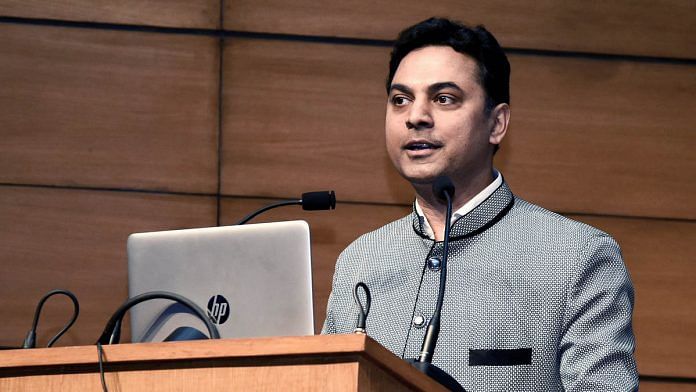New Delhi: There is a need for higher fiscal spending at this time, especially in infrastructure, to aid economic revival, said Chief Economic Advisor (CEA) in the finance ministry Krishnamurthy Subramanian Saturday.
In an interaction with a small group of journalists just two days before the presentation of the Union Budget for 2021-22, Subramanian said the fiscal support should continue till India goes back to the pre-Covid growth path by 2022-23.
Asked if the government should look at income tax cuts to revive demand, Subramanian said the specifics are not as important as the need for greater fiscal spending during this time, while adding that infrastructure spending will also encourage private investment.
“Fiscal multipliers are much higher when the money is spent on infrastructure because it crowds in private investment. Infrastructure spending leads to construction activity and construction activity has both forward and backward linkages. It brings in a lot of jobs in the informal sector and firms all through the supply chain actually benefit,” he added.
“For India (there are studies) which show that if you spend one rupee on revenue spending, the multiplier is basically 0.98. But if you spend it on infrastructure for the one rupee you spend, you get about two and a half. But over the period of the full return from infrastructure, you get about four and a half,” he said.
Subramanian said India’s potential growth is around 6.5 to 7.5 per cent and India should see these pre-Covid growth levels by 2022-23. He added that may be the right time to exit fiscal expansion.
“By FY 23, I reckon that we should be back to the pre-Covid growth path in terms of the growth rates. So, that might be actually the right time to start the consolidation,” he said.
The economic survey 2020-21 presented by Subramanian Friday has advocated countercyclical fiscal measures or basically increasing spending during a recession and cutting back during a boom.
Also read: Modi govt reforms will ensure Covid doesn’t ruin India’s growth potential, CEA Subramanian says
2-6% inflation band has served India well
Subramanian also said that the 2-6 per cent inflation targeting band has served India well so far and also anchors inflation expectations.
The monetary policy targeting framework is set to be reviewed later this year even as the Reserve Bank of India has favoured retaining the existing limits.
At present, the monetary policy committee is mandated by law to target a 4 per cent inflation with a range of plus-minus 2 per cent.
India may be in ‘exit phase’ in the pandemic
Subramanian said that after the Covid-19 cases peaked in September, there was a fear that there could be a surge due to the festive season.
But since then, India has managed to bring down its cases.
“After that (the festive season), India has seen decreasing cases and increasing mobility. “So far, I think… it looks like we are in the exit phase, you know, and the vaccination should help,” he added.
Subramanian was also of the view that a bad bank may not be a bad idea as it would help in speedy resolution of stressed assets. He also said how a section of bankers like K.V. Kamath are of the view that the bad debts problem coming out of the pandemic may not be as big as projected.
The chief economic advisor went on to add that the top six state-owned banks that do more than two-third of the lending have handled their loan books well after learning from past instances.
On the stock markets
The CEA said that the rise in stock prices could be attributed both to the fact that stock markets value future growth of companies as well as to the surplus liquidity globally.
He pointed out how India provides opportunities to global investors that other countries don’t.
A country as large as India, with close to $3 trillion of GDP, growing at 6.5-7 per cent over the next decade presents opportunities to investors, he said.
But in the short term, the abundance of liquidity globally is leading to an increase in valuations, he said, cautioning that this may change by FY 2024 when liquidity conditions tighten around the world.
Also read: Govt studying Covid-19 impact for fiscal stimulus package: CEA Krishnamurthy Subramanian



